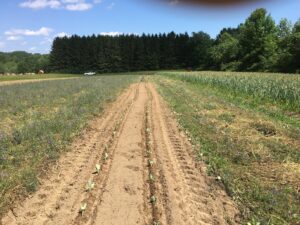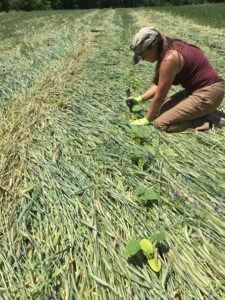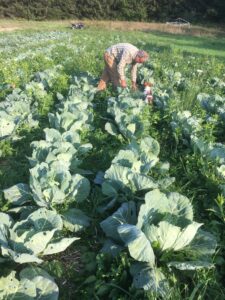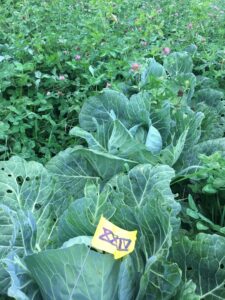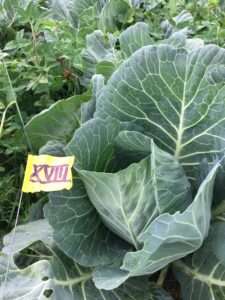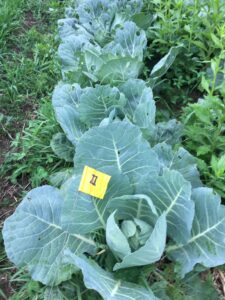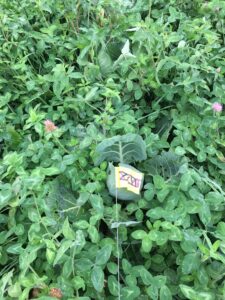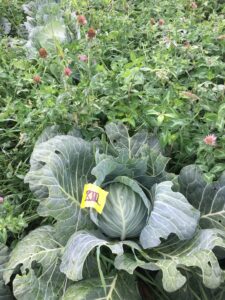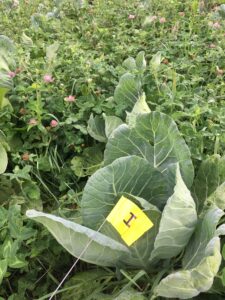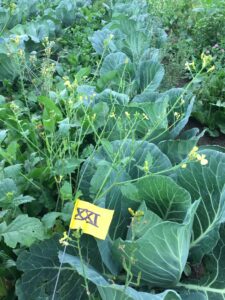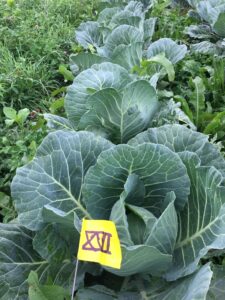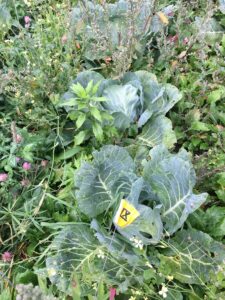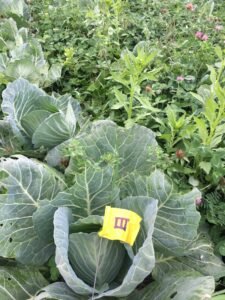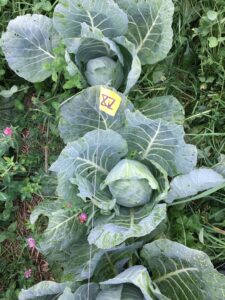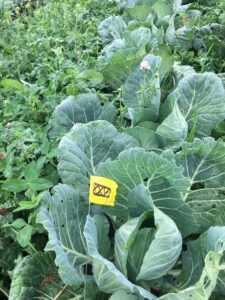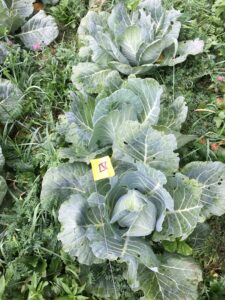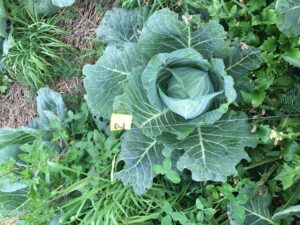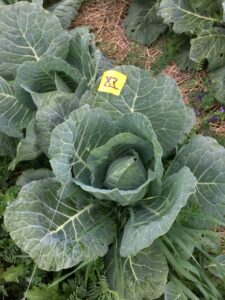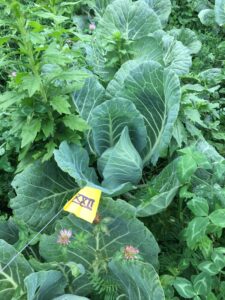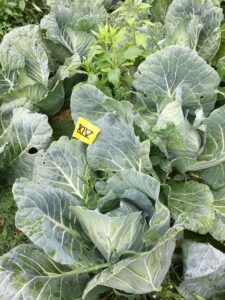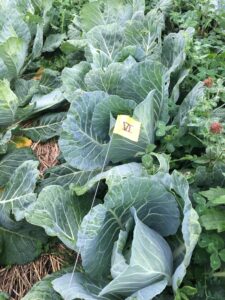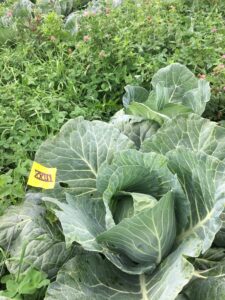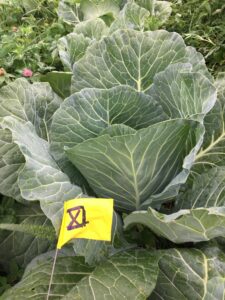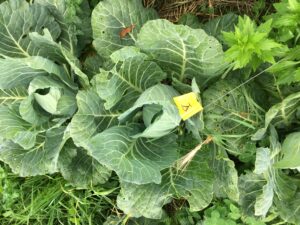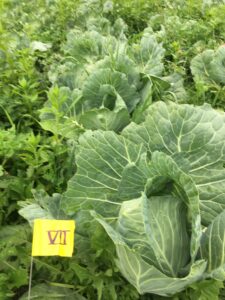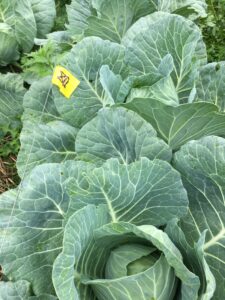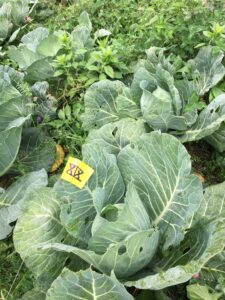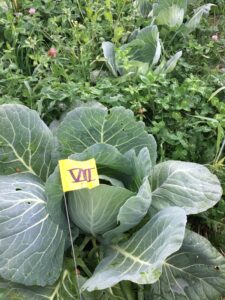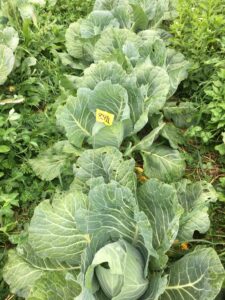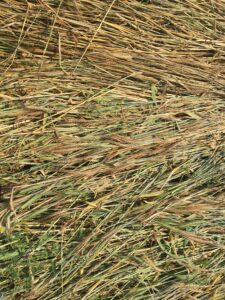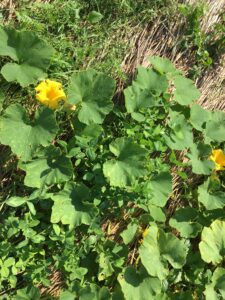Final report for FNE19-924
Project Information
The objective of this project was to determine the effect of seeding rates of a mixed cover crop on both weed control and nitrogen availability measured by the yield and quality of a transplanted vegetable crop through the terminated cover crop. For this trial triticale and vetch were selected whereby the triticale would provide the biomass needed to provide weed control that vetch by itself won't. In September of 2019, 24 plots were planted for comparison with 3 replications of 8 different seeding rates. Cabbage was planted through the rolled and crimped cover crop and harvested for data collection purpose only, and no real difference in weed control or yield between the seeding rates was observed. Yields were generally higher in the cover crop plots as compared to the control plots. The trial was partly replicated in 2020. That year winter-squash was selected as vegetable and only the high rate of triticale was used with the hope to have better weed control. The full rate of triticale proved to be fatal for N availability for a vegetable crop even in a vegetable with low N needs. Yields were 25% of what can normally be expected. The second trial confirmed that planting non-leguminous vegetable crops through cereal (or partly cereal) cover crops decreases yields while failing to provide proper weed control.
Results and preliminary results were communicated in a variety of ways. Preliminary results were part of a presentation at the GLEXPO (Great Lakes Expo) conference in the winter of 2020 as part of the weed control session. there were sixty participants at this session. In 2021 a twilight meeting was held at Philia Farm and 45 growers attended as well as service providers and the NY State Commissioner of Agriculture. In March of 2022 a presentation will be given on this topic as part the Soil Health session at the Empire State Producers Expo.
The question and objective of this trial is to find out if there is a sweet-spot whereby selecting a correct seeding rate between a legume and a cereal can provide proper weed control without negatively affecting availability of N to the vegetable crop. The goal is to lower the barriers of adopting reduced tillage through the planting of fall harvested vegetables through a rolled and crimped cover crop.
There is a great interest in reduced tillage amongst many organic farmers. Organic vegetable crop production, dependent on frequent tillage for the purpose of weed control, can be hard on soil health. Frequent tillage disrupts aggregate stability, depletes organic matter, and reduces long term soil biology. Farmers are aware of these disadvantages but still have great apprehension towards adopting no-till planting of vegetables because of poor weed control and availability of nutrients. Since conventional weed control equipment cannot deal with the biomass of the cover crop, a successive vegetable crop can be lost due to weed pressure. While winter rye provides the best weed control, this system reduces the yield of the vegetables due to poor availability of nutrients especially N. Using leguminous cover crops for no till planting of vegetables provides a much better C/N ratio to ensure good yields, but this also breaks down before the vegetable crop provides sufficient canopy. Fall cabbage was selected as a vegetable crop as the assumption is that if the trial is successful for this crop, it will work for fall harvested sweet-corn, winter squash, as well as broccoli, cauliflower and kale.
What prompted me to research planting vegetables through a cover crop was the inspiration by the work of organic row crop farmers planting field corn in rolled and crimped hairy vetch: (https://rodaleinstitute.org/science/articles/reduced-tillage-organic-corn-production-in-a-hairy-vetch-cover-crop/). Was it possible to replace field corn with a fast maturing vegetable crop? Being part of the DACUM (Design A Curriculum) work group on reduced tillage in 2015 provided me with the opportunity to network with farmers leading this kind of work in the Northeast. What was striking was the lack of success amongst these farmers to obtain optimum yield under no-till conditions (except for green beans and edamame). Recent work with tillage radish for early-season, no-till spinach looks very promising (LNE-11-312). Project manager Lounsbury notes that this is not a good fit when planting brassicas, and of course this cover crop doesn’t provide any nitrogen (although an excellent trap crop for N). Nevertheless, this work certainly provides one piece of the no-till puzzle. Most of the other work with no-till or reduced-till vegetables uses permanent raised beds. Jay and Polly Armor have been using permanent beds for up to 17 years (http://www.mofga.org/Publications/The-Maine-Organic-Farmer-Gardener/Summer-2014/No-Till), and other locations such as Tobacco Road Farm are using similar systems (https://thenaturalfarmer.org/article/no-till-vegetables-at-tobacco-road-farm). The concern here is if compost used for this system is based on animal manure, will the soil over time be saturated with nutrients, possibly leading to pollution of surface and ground water and/or tying up of micro-nutrients?
My first experience with planting vegetables through a leguminous cover crops was at the Hudson Valley Farm Hub. In my position as Associative Director directing the ProFarmers Program, we successfully planted vegetables through a leguminous cover crop in 2017. Weed control was our main culprit so for wider adoption we needed to address this issue, prompting this research grant. Leguminous crops do not provide the ideal biomass for weed control (approx. 2500 lbs. whereby 4000 lbs. is considered the minimum coverage that is needed for successful weed control) ); therefore, some cereal crops should be part of the mix in to obtain better coverage. The problem with adding cereals is that these crops deprive the successive vegetable crop of needed nitrogen, so the question was if there was a sweet spot of seeding rate between a cereal and a legume. Triticale was selected as a companion of hairy vetch as the assumption is that its maturation (anthesis) falls a week later than rye.
The other issue that needed to be addressed was the modification of existing planting equipment as no-till planting equipment is prohibitively expensive. A conventional model 5000 mechanical transplanter was available to be used for this work.
At our current operation, Philia Farm, we hope that this method will allow us to incorporate a row crop like cabbage, broccoli, sweetcorn, or winter squash in our current three year rotation that is centered around the production of seed garlic. In our current rotation we include triticale and hairy vetch as a cover crop followed by a bare fallow and oats and peas. Instead, we could choose to include another cash crop year by planting directly through a rolled and crimped cover crop.
I am a graduate of the Groenhorst College, a biodynamic agriculture school in the Netherlands. I focused my studies on integrated farming operations. I have been a biodynamic/organic farmer since 1985 and founded Roxbury Farm in 1990 which grew to become a 350 acre integrated operation. I have experimented with many different cover crops to increase soil health although my farming career. During 2014 and 2017 I was employed at the Hudson Valley Farm Hub in Hurley NY. There, I was responsible for the creation of a Farmer Training Program and oversaw the transition to organic and ecological practices of the 1200-acre former sweet corn farm. In 2019, my wife Crystal Stewart and I founded Philia Farm. Here we combine our interest in research on regenerative farming practices and the production of vegetables and seed crops.
Cooperators
- - Technical Advisor (Educator and Researcher)
Research
Spring 2019
Soil in the research plots was tested in May indicating low potassium and phosphorus levels and sufficient to high calcium and Magnesium levels. For details here is the soil test: SM027211
Summer 2019
- The plots were subsoiled with a Yeoman (Keyline) plow to break the plow pan, and the fertilizer was incorporated with a rotary tiller. This was followed by repeated disking in order to kill the perennial grasses and weeds in the sod. While the weed pressure might have been lower when a mold board plow was used, the decreased disruption of the soil below 4 inches was part of the reduced tillage approach.
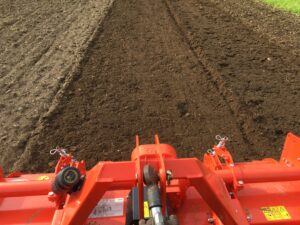
Breaking sod with the rotary tiller. - Composted Chicken Manure in the amount of 1000 lbs per acre was applied as well as 100 lbs of Potassium Sulfate per acre in addition to 60 lbs of woodash. This was incorporated with a Perfecta II Harrow to create a smooth seedbed.
- Buckwheat was planted on June 27th at 80 lbs. per acre as a weed suppression.
- The Buckwheat was worked under at August 5th with a disk. In order to prepare the ground for triticale and hairy vetch, one additional pass was needed with the disk .
-
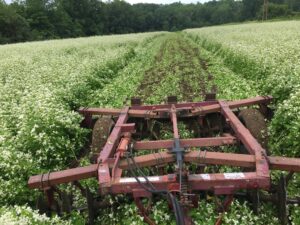
Incorporating buckwheat with a disk.
August-September-October 2019
- Additional fertilizer was applied on August 12 in the form of composted poultry manure in the amount of 1500 lbs. per acre. Based on the soil test this final application should have corrected any nutrient deficiency.
- Before planting a smooth and level seedbed was created to ensure effective rolling and crimping the following year. A Perfecta II harrow was used three times as the ground originally found in sod proofed to be quite uneven.
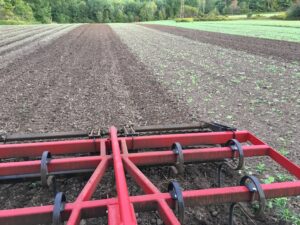
Weed control with Perfecta II harrow. - In order to plant the correct amount of triticale and vetch in each plot the grain drill (an old John Deere 930) had to be calibrated. The calibration chart inside the seed box had proven to be quite accurate for the buckwheat so my hope was that this would work as well for the triticale and vetch. Unfortunately, 20 lbs. increments of triticale or vetch are challenging settings on this old drill.
- The plots were planted on September 13th and 14th. Each plot was covered 6 times opening and closing the drill as based on the application . The calibration was set on close to 20 lbs per acre and each plot was seeded in either 20, 40, 60 or 80 lbs. of triticale. The following day the grain drill was cleaned out and calibrated for vetch. Each plot received either 20 or 40 lbs. of vetch.
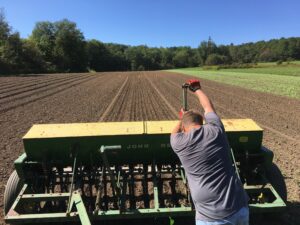
Seeding the plots with the 8 different seed mixes using an old JD grain drill. - Flags were planted in each plot whereby each green flag represents 20 lbs of triticale and each orange flag 20 lbs of vetch. The map was also created in digital format for future reference and in case the flags would disappear over the winter. Here is a map of the trial: SARE NT trial 2019-2020 New Map
- Due to a relatively wet fall the triticale and vetch came up quickly which also promoted plenty of winter annuals like yellow rocket, annual bluegrass and some mustard to germinate.
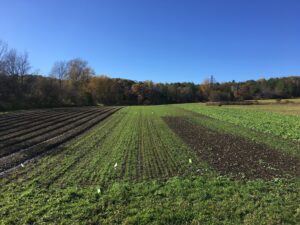
Spring 2020
In the month of May the existing 5000 WD Mechanical transplanter was converted to plant through a cover crop In order to mount a coulter in front of the planter to cut the cover crop, the frame had to be extended to provide the needed space between the 3-point hitch and drive wheel.
The assumption to be able to use a regular transplanter is that the field was worked in the fall and the ground remains relatively soft as compared to permanent no-till conditions. Special brackets and space bars were custom welded by Mechanical Transplanter to meet the specific needs of this project. An additional 2 1/2 toolbar needed to be installed to mount the wavy or straight coulters.
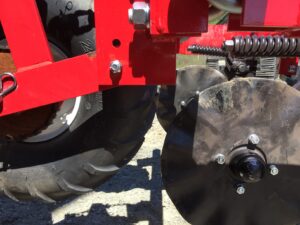
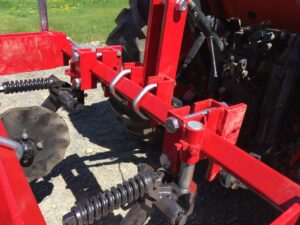
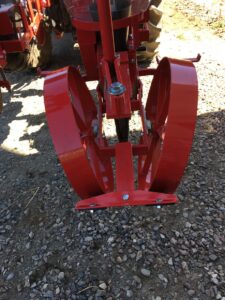
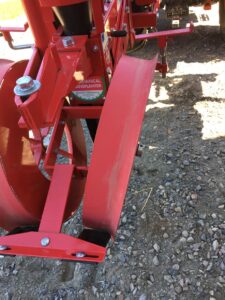
In order to provide better closing of the furrow under no-till conditions, the packing wheels were replaced. The traditional packing wheels with edge might float under the cover crop conditions (see pictures).
June 2020
Cabbage was seeded in Winstrip 72 cell trays during the week of May 26th. 90 trays were seeded using 7000 seeds of the variety Passat F1, that were generously donated by BeJo Seeds USA. This is a dense cabbage yielding under ideal circumstances between 6 to 8 lbs.
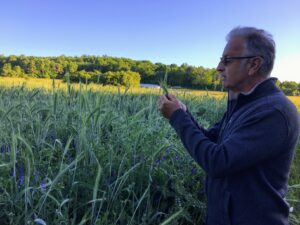
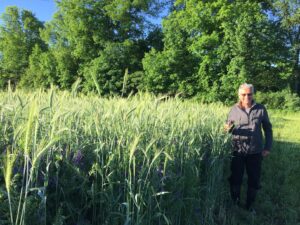
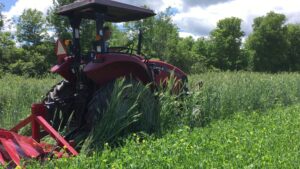
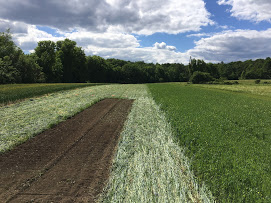
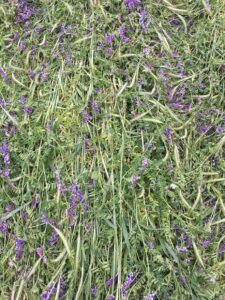
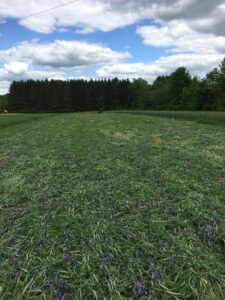
July 2020
On July 6, 2020 cabbage was transplanted through the cover crop. Triticale was sufficiently died down while the vetch even after rolling a second time was still alive and starting to set seed.
Thanks for the help of Crystal Stewart-Courtens and Chuck Bornt for helping us out those two days with the planting.
September 21, 2020
The cabbages were exposed to unusual hot and dry weather through the summer and needed frequent irrigation. During September the rolled and crimped cover of vetch and triticale started to disappear, and weeds started to appear as an understory. In the control plots we found more common annual weeds like lambsquarter, orchard grass, mustards and wild radish. In the rolled and crimped plots, the weeds consisted (predominately) of medium red clover (trifolium pratense), black eyed Susan (rudbeckia hirta), reseeded hairy vetch (vicia villosa), some dandelion (taraxacum officinalis), and goldenrod (solidago).
November 2021
Cabbage was harvested and weighed.
2021
A new plot was seeded down in the fall of 2020 with triticale and vetch. All plots were seeded down with 100 lbs of triticale and 20 lbs of vetch. The hope was by achieving optimum weed control we would limit the competition of weeds. This year the soil was adequately fertilized and soil tests revealed that K was optimally available.
The squash was protected with floating row covers against flea beetles and initially progressed well
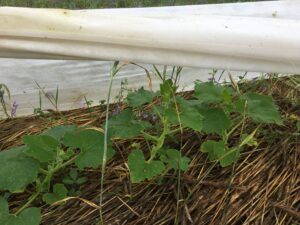
One important factor in obtaining good yields is through optimal weed control. The assumption of this trial was that this can be accomplished by:
1. introducing an effective bare fallow in the previous year.
2. By seeding at the correct time assuring good coverage before the winter months and early spring development.
The field selected for research had been for over 20 years in hay. While it is customary to use a moldboard plow when turning over a perennial pasture or hayfield back in crops, for the purpose of this trial any form of horizontal tillage was avoided. This was a mistake as moldboard plowing would have eliminated many of the perennial weeds and buried the weed seed bank (primarily clover and grass seed) that were present on the surface. The weed seed bank continued to hamper the results of the trial even in year 2.
September 14 proofed to be too late for our northern region in the Adirondacks. In our region a seeding date of September 1 should be recommended. We adjusted this for Year 2 and initially had superior coverage and early development.
In 2021, the Sept 14 seeding of triticale vetch mix fared well over the winter and the difference in ground coverage between the mixes was obvious. The heaviest mix of 80 lbs of triticale with 40 lbs of vetch had obviously the best ground coverage.
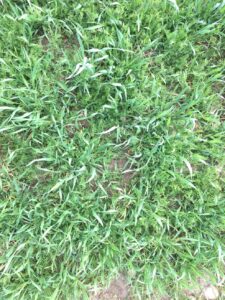
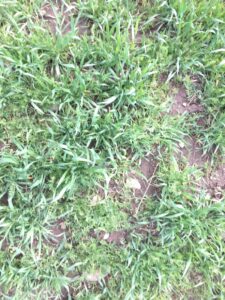
The photo on the left (taken on May 5th) showed a typical heavy seed mix while the photo on the right shows a light seed mix. There is obviously more shading in the heavy seed mix but very few weeds seem to have taken advantage of this. The triticale and vetch start growing vigorously during the month of May and no other weed identification was done as the canopee closed quickly.
In 2021, the triticale reached anthesis on June 15th. At certain test plots the vetch was overbearing and forced the triticale to lodge. In this picture the heavy seed mix with no lodging is featured.
There did not seem to be a direct correlation between lodging and amount of vetch in the mix. The 500 feet long field showed consistent lodging in the middle of the field in almost all seed mixes. There might be a correlating effect between possible potassium deficiency and lodging but is based on the most obvious difference we found. We know that the natural fertility in this field is best on either as we carefully monitor the yield of garlic in this field. Lodging can present numerous problems when trying to plant through the rolled cereal as will be made clear later in this report. In order to kill the vetch we had to roll and crimp three times which might have caused unnecessary compaction.
On July 6, 2020 cabbage was transplanted through the cover crop. The assumption was that one does not have to use a specific no-till transplanter to penetrate a rolled and crimped cover crop. Since we had to drive over the test site at least 6 times to establish the site followed with repeated rolling after anthesis, the surface became too hard to penetrate with a regular transplanter. This was not a negative from a research perspective as we were forced to solve this problem with the tools available. We successfully modified the planter by weighing it down with cinder blocks and replaced the wavy coulter with a larger straight coulter.
The first day was spent much in changing over the initial set up as the planting proved to be a real challenge.
- The transplanter worked well on the first day, as we had received an inch of rain a few days earlier. It is important to have sufficient soil moisture for the planter to penetrate and the closers to work properly.
- Not being able to roll the triticale in one direction was challenging and the changes that we were forced to make might not have been needed if the vetch had not caused the triticale to lodge.
- The lighter 2 ½ inch diamond toolbar frame did not provide enough weight for the front coulters to sufficiently cut through the mess of triticale that was laid down in all kinds of directions. We ended up using 9 cinderblocks adding 300 lbs of weight to the frame.
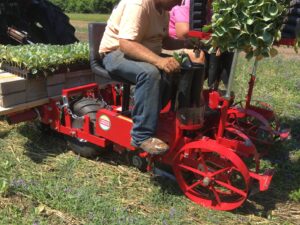
Look for the 9 cinderblocks mounted on top of the frame to provide extra weight on the coulters. - The wavy coulters were not doing their job as they did provide a nice slicing effect to be followed by the double disk openers of the planter. We exchanged the wavy for the larger straight coulters which allowed us to set them deeper and provide a better slicing effect even when cutting perpendicular through the straw.
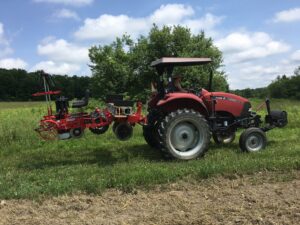
The larger straight coulters mounted before the double disk openers were set about 6 inches deep to provide proper slicing of the straw cover.
Once we made all these changes, the planting went very smoothly the following day.
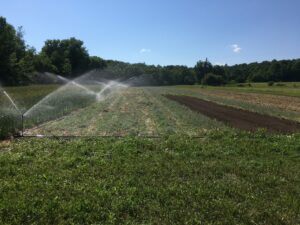
What also helped was to add another .25 inches of irrigation to provide optimum moisture of the soil.
video of transplanting cabbage
second video transplanting cabbage
Besides the competition of the weeds, some of the growth was hampered by planting in compacted conditions as well. When a soil penetrometer was applied, a resistance was measured between 200 and 250 psi at 7 to 9 inches in all plots. While the deeper compaction was a problem for the crop to penetrate the soil, surface compaction had in some cases caused to bend the lower part of the stem. The retarded growth of cabbage plants showed a 90 degree bend between the stem and the root. This was most certainly caused during transplanting. This proofed to be an even greater limiting growth factor than the competition from weeds.
While the color of the cabbages in each plot looked correct, on September 21 tissue culture was taken and sent to Waters Agricultural Laboratory. Here are the results:
[P] (10-14-2020) PHILIA FARM - JOHNSTOWN
The tissue culture test showed that the competition in the rolled and crimped plots between medium red clover and cabbage resulted in low levels of nitrogen, potassium, boron, zinc and copper. Despite adequate application of amendments (as according to the soil test) even the control plots showed a deficiency of potassium and copper, but the absence of red clover reduced any other deficiencies.
These photos were taken on September 28.
November 18 cabbage was the harvest date. None of the cabbages were marketable as they were not completely sized up and/or firm. Nevertheless to obtain comparable results 25 continuous feet of representative cabbages were harvested and weighed in each plot . While they were mostly full-size they lacked proper firmness which made them unmarketable. While a July 6 date of planting cabbage is not considered too late under normal circumstances (we have done this in many other years with good results), the hot summer conditions in combination with low N and K levels slowed down maturity. It should be noted that other growers in the area reported having plowed down cabbage due to the hot summer.
While the control plot indicated greater availability of nutrients, cabbage was even less firm than in the rolled and crimped plots, indicating that the mulch must have provided a slight amount of cooling of the soil.
In 2021, we the higher quantity of triticale reduced lodging but the weed control was equally challenging. By comparing seeding dates we could see the impact on early spring development. Here is a picture of triticale seeded two weeks apart in 2020:
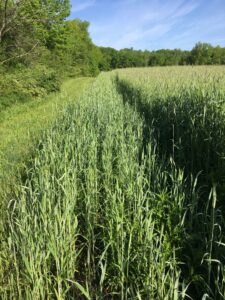
In 2022 Winter squash was planted on June 13 closely after rolling and crimping the triticale and hairy vetch.
Part of the field that was not planted in squash was used to observe if hairy vetch could be killed by light disking. This took place on June 19. Here the disc is set at the least aggressive setting to avoid working up soil. This was done to imitate the action of a no-till drill with coulters that make a cut every 7 inches which had proven to be effective in the past to eliminate hairy vetch:
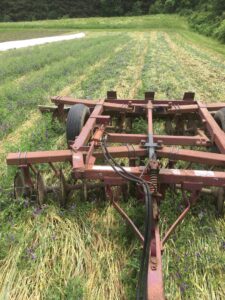
Triticale and vetch after discing.
This did not replace the more aggressive way of terminating vetch by means of a no-till drill. It did set the vetch back but did not suppress it completely.
By August soil nutrients ran out and despite ample moisture (2021 was a very wet year)
Squash August 25, 2021
Squash was harvested in October (due to a very warm September) and yields were very disappointing (25% of average yield in conventional tilled conditions).
While we had to cancel our field day in 2020 we were able to hold a twilight meeting for 35 growers and service providers in July of 2021. This was very successful and we were able to provide them with 2 years of experience planting vegetables through a cover crop.
Conclusion of this trial is that cereals should not be used when planting vegetables through a cover crop. Options for success to plant vegetables through a cover crop is to plant strictly legumes. The grower has a choice of fall planted vetch or Austrian winter peas or a spring planting of 4010 field peas with bell beans. After crimping the smaller grower has the option to further terminate the cover crop by the use of a tarp. The mid size grower can further terminate the legume by use of a no-till drill or a light discing, and control weeds by use of a high residue cultivator: https://www.sare.org/publications/steel-in-the-field/row-crop-tools/cultivator-high-residue/In summary we can conclude for 2020 that there was little evidence that yield improved or decreased due to the different seeding rates of triticale. At the lower rates the triticale was prone to greater tillering leading to similar amount of biomass. There also did not seem to be a great difference in weed pressure between the different seeding rates. Even within the plots there was a sizable yield difference between plants. The latter was more depending on individual growth retarding factors like competition with clover, lack of K and compaction. Both the lowest and the highest yield were harvested in the rolled and crimped plots. The highest yielding treatment was where 20 lb. of vetch with 80 lb. of triticale was seeded, while the lowest yield recorded was in the plots with 20 lb. of vetch with 60 lb. of triticale. Yield reduction in three areas of the field are contributed by compaction. This explains the little variation between the control plots as they did not suffer from surface compaction during planting as these sections were rototilled prior to planting. What is very important to note is that when everything worked (fewer weeds, less compaction), the rolled and crimped plots outperformed the control plots by 50%! Yield variation between individual plots was 300%. The control plots had a 200% yield increase compared to the lowest yielding rolled and crimped plot.
In 2021, we hoped for better weed control by increasing the seeding rates. This proved to confirm the assumption that high seeding rates of triticale decrease yield as this removes too much N out of the soil. Even though squash only requires approximately 40 lb of N (as compared to 150 lb of N for cabbage), yields were dismal in the rolled and crimped cover crop. Squash was harvested on September 28 and yields were around 25% of what you would expect in a normal years (Around 8,000 lbs per acre as compared to 24,000 lbs.). The control plot that was planted through black plastic yielded higher than usual with the equivalent of 32,000 lbs per acre.
Education & Outreach Activities and Participation Summary
Participation Summary:
I have reported on this work through the weed control webinar at the GLEXPO (Great Lakes Expo) as part of the weed control session for organic growers. 60 growers were present for this. In July of 2021 in collaboration with CCE ENYCHP (Cornell Cooperative Extension Eastern NY Commercial Horticulture Program) a twilight meeting was hosted at Philia Farm where there was an opportunity to share the experiences of the trials in person. 45 growers and extension educators attended this meeting. The NY State Commissioner of Agriculture was present as well as the local NRCS (National Resource Conservation Service) and FSA (Farm Service Agency) service providers. The latest presentation on this topic was to be given at the Empire State Producers Expo in Syracuse in January but has been rescheduled to March 8 as part of the session on Soil Health.
Learning Outcomes
The only farmer that is able to report having changed knowledge, attitude, skills and/or awareness that can be measured is the participating farmer. While the results will or have been reported to about 100 farmers it is difficult to measure if this has/will change(d) anything about their knowledge attitude, skills or awareness.
First, the research plots were larger than necessary to yield results. The diversity of the trial caused compaction (by making 6 passes over the field) that artificially decreased the yield of the cabbage. This information changed the trial design in 2021. Both trials confirmed that the two main obstacles of planting vegetables through a cover crop are weed control and availability of nitrogen.
Second there was a learning proces in how to adjust conventional planting equipment to be used for planting through a cover crop. This was conveyed to other growers and service providers during our twilight meeting, presentations and articles. This might reduce at least one of the thresholds for many growers to implement this method as no-till planting equipment is excessively expensive.
Lastly, planting through a cover crop within an organic system will require a different approach depending on what scale someone is working in. It will be easiest to adopt in a large scale or very small scale production system. It will be most difficult to adopt in a mid size farm. Large scale organic vegetable farmers (over 30 acres of vegetables) it is viable to acquire modified weed control equipment that is currently used by organic field crop farmers. Small scale (3 acres and less) vegetable farmers have the option to terminate a leguminous cover crop and small weeds with a tarp before planting. For the mid-size vegetable farm (smaller than 30 acres and larger than 3), a tarp is too smal of an area and the modified equipment is out of reach.
Project Outcomes
The goal of this project was to lower the barriers of adopting reduced till and no till planting of mid-season vegetables. We did not accomplish that goal. This trial confirmed that further research is needed to create tools that remove the existing barriers of adopting this method.
Conclusion of this trial is that cereals do not fit well in a system of rolling and crimping in an organic vegetable system. While the objective of the trial was to see if there is a sweet spot in how much cereal one should plant in relation to a legume, the outcome was that any amount of cereal in the mix is detrimental to the development of a non leguminous vegetable crop. It confirmed the results of earlier successes with this system when only hairy vetch or Austrian winter peas were used. This trial did not reduce inputs, reduce employee input, it decreased yields, but it was a teachable event for many growers in the area to be careful in adopting new systems that sound good on paper but are more difficult to put into practice.
One success story is the successful adaptation of a conventional mechanical 5000 transplanter to be used as a no-till transplanter. This is something that can be successfully adopted by conventional growers that are able to use herbicides and urea. At our twilight meeting the ratio of organic versus conventional vegetable growers was about 50%. Given that weed control and nitrogen is less of an issue for conventional growers, I can see how this was a larger hurdle for them to overcome.
The trial also confirmed that timely planting of the overwintering cover crop is essential for good coverage and that the use of cereals as a cover crop in this system is not advisable for organic vegetable farmers.
While overall yields were dismal, it was obvious that water management in the no-till plots was superior. In the areas where compaction did not negatively affected the trial, yields were considerably higher than the control plots. There continues to be potential in fine-tuning this methodology.
We will continue to plant leguminous cover crops to precede fall planted brassicas but will focus on better termination of both cover crops and weeds.
This trial indicated that future research should be focused on:
- Better methods for termination of leguminous cover crops aside from rolling and crimping (tarping for smaller growers and the use of a no-till drill that effectively slices the vetch which terminates it)
- Better methods for weed control (like the use of high residue cultivators ) to eliminate weeds before or after establishment of vegetable crop.
